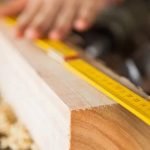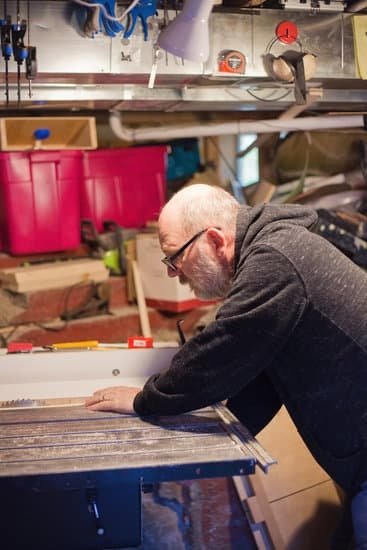Wood moisture content is a crucial factor to consider in woodworking, as it can greatly affect the quality and outcome of your projects. Understanding how dry wood needs to be for woodworking is essential for ensuring the durability and stability of your creations.
In this article, we will delve into the significance of wood moisture content, optimal levels for different woodworking projects, testing methods, wood drying techniques, risks of using wet wood, proper wood storage, and tips for selecting the right type of wood.
The moisture content of wood refers to the amount of water present in its cellular structure. It is typically expressed as a percentage based on the weight of the water in relation to the weight of the wood when it is completely dry. The moisture content affects not only the workability and stability of wood but also its susceptibility to decay and fungal growth. Therefore, having a good grasp on this concept is vital for anyone involved in woodworking.
To achieve successful woodworking results, it is important to use properly dried wood. Using wood with high moisture content can lead to warping, cracking, or even mold growth in finished projects. Understanding the optimum moisture content for different types of woodworking projects can help ensure that you achieve long-lasting and professionally crafted pieces. Whether you are working on furniture, cabinetry, or smaller decorative items, having knowledge about wood moisture content is key to achieving success in your woodworking endeavors.
Importance of Dry Wood for Woodworking
Wood with the right moisture content is crucial for a successful woodworking project. The importance of using dry wood for woodworking cannot be overstated. When wood is too wet, it can lead to a host of issues that can ruin your project and waste your time and money.
Preventing Warping and Cracking
One of the main reasons why dry wood is essential for woodworking is to prevent warping and cracking. When wood contains too much moisture, it can warp as it dries, leading to uneven surfaces and misaligned joints. Additionally, the excessive moisture in the wood can cause it to crack as it dries out, which can ruin the overall appearance of your project.
Improving Strength and Stability
Using properly dried wood also improves the strength and stability of your woodworking projects. Wet wood is weaker than dry wood, making it more susceptible to breaking or bending under pressure. By using dry wood, you ensure that your finished piece will be strong and durable.
Achieving Better Finishes
Furthermore, using dry wood enables you to achieve better finishes on your woodworking projects. Wet wood can cause issues with paint adhesion or finishing products like varnish or stain. Dry wood allows for a smoother and more consistent finish, enhancing the overall quality and appearance of your work.
In conclusion, understanding how dry does wood need to be for woodworking is crucial in ensuring the success of any woodworking project. By using properly dried wood, you can avoid issues such as warping and cracking, improve the strength and stability of your projects, and achieve better finishes on your completed pieces.
Optimal Wood Moisture Content for Different Woodworking Projects
When it comes to woodworking, the moisture content of wood is a crucial factor to consider. The optimal wood moisture content can vary depending on the specific woodworking project you are working on. Different projects require different levels of dryness in the wood in order to ensure good quality and long-lasting results.
Wood Moisture Content for Indoor Furniture
For indoor furniture projects, it is recommended that the wood has a moisture content of around 6-8%. This level of dryness helps prevent warping, cracking, and shrinkage once the furniture is completed and placed in a controlled indoor environment. Using wood with higher moisture content for indoor furniture can lead to structural issues over time, so it is important to properly dry the wood before starting your project.
Wood Moisture Content for Outdoor Projects
When it comes to outdoor woodworking projects such as garden furniture or decking, using wood with a slightly higher moisture content is advisable. Aim for a moisture content of around 12-15%, as this will allow the wood to better withstand outdoor conditions and exposure to the elements without excessive shrinking or cracking.
Wood Moisture Content for Musical Instruments
For more specialized woodworking projects such as crafting musical instruments, achieving an optimal wood moisture content is crucial for both sound quality and durability. The ideal moisture content for instrument making can vary depending on the specific type of wood being used, but generally falls between 6-10%. This range allows the wood to resonate properly while also maintaining its structural integrity over time.
Understanding the optimal wood moisture content for different woodworking projects is essential for ensuring that your finished pieces are of high quality and long-lasting. By properly drying and testing the moisture content of the wood you use, you can avoid potential issues such as warping, cracking, and structural instability.
Testing Wood Moisture Content
Wood moisture content is a crucial factor to consider in woodworking, as it greatly affects the quality and durability of the finished product. Testing wood moisture content is important to ensure that the wood is at the optimal level for woodworking projects. The ideal moisture content for woodworking typically ranges from 6% to 8%, although this can vary depending on the specific type of wood and the climate in which it will be used.
There are several methods for testing wood moisture content, including using a moisture meter, oven-drying method, or moisture content probe. A moisture meter is a popular tool used by woodworkers to quickly and accurately measure the moisture content of wood. This device works by measuring the electrical resistance between two metal probes inserted into the wood, providing a reading of its moisture content.
In addition to using a moisture meter, some woodworkers may opt for the oven-drying method to test wood moisture content. This involves weighing a sample of wood, then drying it in an oven at a specific temperature for an extended period of time before reweighing it to determine its final weight. The difference in weight provides insight into the amount of water that was present in the sample, indicating its moisture content.
| Method | Description |
|---|---|
| Moisture Meter | A tool that measures electrical resistance between two probes to determine wood moisture content. |
| Oven-drying method | Weighing a sample of wood, drying it in an oven, and reweighing it to determine its final weight and thus, its moisture content. |
Methods for Drying Wood
Wood must be properly dried before it can be used for woodworking projects. The ideal moisture content for wood used in woodworking is typically between 6% and 8%. This level of dryness helps to ensure that the wood will not warp or crack once it has been crafted into a final product.
One common method for drying wood is air-drying. This involves stacking the lumber in a way that allows for good air circulation, such as placing thin sticks between each layer to create gaps. Air-drying can take several months to complete, but it is an effective and natural way to reduce the moisture content of wood.
Another method for drying wood is kiln-drying. Kiln-drying involves placing the wood in a large oven-like structure where temperature, humidity, and airflow can be carefully controlled. This method can significantly speed up the drying process, making it possible to achieve the ideal moisture content in a matter of weeks rather than months.
Finally, some woodworkers also use a combination of air-drying and kiln-drying to achieve optimal results. By initially air-drying the wood to remove a significant portion of the moisture and then finishing off the process in a kiln, they are able to obtain the best of both methods.
| Drying Method | Time Required |
|---|---|
| Air-Drying | Several Months |
| Kiln-Drying | Several Weeks |
| Combination Method | Varies depending on initial moisture content |
Risks of Using Wet Wood for Woodworking
Using wet wood for woodworking projects can result in several risks and issues that can affect the quality and durability of your finished product. From warping to mold growth, using wood with high moisture content can lead to a range of problems. Here are some of the risks associated with using wet wood for woodworking:
1. Warping: One of the most common issues with wet wood is warping. When the wood dries unevenly, it can lead to twisting, bowing, or cupping, which can ruin the straight lines and smooth surfaces you intended for your project.
2. Mold and Rot: Wet wood is susceptible to mold and rot, especially if it is stored improperly or left in damp conditions for an extended period of time. These issues not only compromise the structural integrity of the wood but also pose health risks to those working with it.
3. Difficulty in Joinery: Wood that is too wet can make joinery difficult as it shrinks as it dries, causing joints to become loose or even fall apart.
To avoid these risks, it’s important to properly dry the wood before using it for any woodworking project. It’s crucial to understand the optimal moisture content for different types of woodworking projects in order to achieve the best results and ensure the longevity of your creations.
Some methods for drying wood include:
– Air Drying: This involves stacking and storing lumber with enough space between each piece to allow air circulation.
– Kiln Drying: Using a kiln to control temperature and humidity levels, which accelerates the drying process.
– Dehumidification: Removing moisture from the air around the wood using dehumidifiers.
– Solar Drying: Utilizing solar heat and airflow to dry out lumber.
Properly dried wood will not only result in better-working material but will also create a more durable finished product that is less prone to issues like warping, mold growth, or trouble with joinery.
How to Store Wood to Maintain Its Moisture Content
Wood moisture content is crucial for woodworking projects, as it can significantly affect the quality and durability of the finished product. Properly storing wood is important to maintain its moisture content and prevent it from becoming too wet or too dry. Here are some tips on how to store wood to maintain its moisture content:
1. Keep it off the ground: Storing wood directly on the ground can cause it to absorb moisture, which can lead to mold and decay. Make sure to store your wood on a raised surface, such as pallets or blocks, to allow for air circulation underneath.
2. Stack lumber properly: When stacking lumber, it’s important to create space between each board to allow for airflow. This helps prevent moisture buildup and promotes even drying.
3. Use a dehumidifier or air conditioner: If you live in a humid climate, consider using a dehumidifier or air conditioner in your storage area to control humidity levels and prevent wood from absorbing excess moisture.
4. Protect from direct sunlight: Direct sunlight can cause wood to dry out too quickly and unevenly, leading to cracking and warping. Store your wood in a shaded area or cover it with a tarp to protect it from the sun.
5. Regularly check moisture levels: To ensure that your wood is maintaining the optimal moisture content for woodworking, use a moisture meter to regularly check the levels. This will help you make any necessary adjustments to your storage method.
By following these tips for storing wood, you can help maintain its optimal moisture content for woodworking projects and ensure that it remains in good condition for future use.
Tips for Selecting the Right Wood for Woodworking Projects
In conclusion, understanding the moisture content of wood is crucial for successful woodworking projects. The importance of dry wood cannot be overstated, as using wood with high moisture content can result in warping, cracking, and other issues that can compromise the quality of the final product. Different woodworking projects may require different levels of wood moisture content, so it’s essential to know the optimal moisture content for the specific project at hand.
Testing wood moisture content is a critical step in ensuring that the wood is at the proper moisture level for woodworking. There are various methods for testing wood moisture content, including using a moisture meter or conducting simple weight measurements over time. By accurately testing the wood’s moisture content, woodworkers can avoid potential problems down the line and ensure they are working with properly dried wood.
When it comes to selecting the right wood for woodworking projects, it’s important to consider not only the type of wood but also its moisture content. Properly storing wood is key to maintaining its moisture content and preventing it from absorbing excess moisture from its environment. By following these tips and guidelines, woodworkers can make informed decisions about selecting and using dry, properly prepared wood for their projects, leading to higher quality results and increased satisfaction with their craftsmanship.
Frequently Asked Questions
How Dry Should Wood Be Before Working?
Wood should ideally be around 6-8% moisture content before working with it. This ensures that the wood is stable and won’t warp or crack as it dries further after being worked.
How Do You Know if Wood Is Dry Enough?
To determine if wood is dry enough for woodworking, you can use a moisture meter to measure the moisture content. Another method is to observe the weight and feel of the wood – dry wood will feel lighter and less cool to the touch compared to wet wood.
Can I Use Wet Wood for Woodworking?
It’s not recommended to use wet wood for woodworking as it can lead to issues such as warping, cracking, and shrinking as it dries. It’s best to allow wet wood to air dry or use a kiln to properly dry it before using it for any woodworking projects.

Hi everyone! I’m a woodworker and blogger, and this is my woodworking blog. In my blog, I share tips and tricks for woodworkers of all skill levels, as well as project ideas that you can try yourself.





